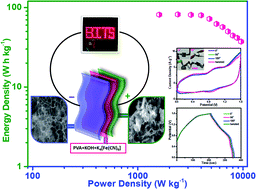A high-performance flexible energy storage device from biomass-derived porous carbon supported MnCo2O4 nanorods and MnO2 nanoscales†
Abstract
The rising demand for portable and wearable electronics, biomedical implants, healthcare gadgets, etc. in the global market is triggering the augmentation of flexible supercapacitor devices that can supply sustainable and efficient energy for an ultra-long time period. In this study, we have developed a high-performance, flexible all-solid-state asymmetric supercapacitor (ASC) device with biomass-derived porous carbon-supported MnCo2O4 nanorods and MnO2 nanoscales (MCO-MnO2-PC) as the positive, and porous carbon as the negative electrode. The fabricated device exhibited excellent energy (81.3 W h kg−1) and power delivery (1600 W kg−1), high rate capability and flexibility, and a long shelf-life with ∼92% retention of CS after ∼5000 consecutive charge–discharge cycles. Besides, the fabricated device is non-harmful to human health and very cost-effective as the electrode materials of the device can be easily synthesized from naturally abundant, low-cost, and non-toxic starting materials. All these attractive properties of the device make it an outstanding candidate that can be utilized for energy storage purposes in state-of-the-art technologies.



 Please wait while we load your content...
Please wait while we load your content...